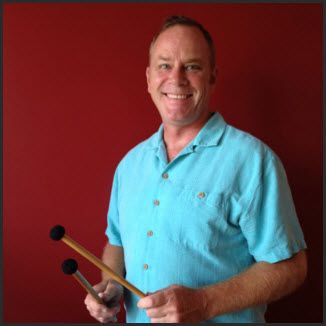A typical set of timpani consists four drums of graduated sizes; 32”, 29”, 26”, 23”. These sizes of drums refer to a set of Yamaha balanced action drums and different manufacturers of timpani will have similar yet slightly different sizes. But, virtually all sets of four timpani consist of a large drum for low notes, two middle range drums and a small drum for high notes.
Watch this video for quick look at the ranges for a set of four Timpani
It’s important to know what each drum’s range is and it’s important to know which notes sound best on each drum. Because, while the 26” drum is capable of playing a Bb, it really doesn’t sound great. So if you have an option you should play that Bb on your 29” drum so it sounds better.
The Two Middle Drums 29” and 26”
In the majority of musical situations you will end up playing most of your timpani parts on these two drums. The range of the 29” drum can go from F up to D and the 26” drum can go from Bb to F#. With these pitches available you’ll be able to play most two drum timpani parts.
The Big 32
This drum is used for low notes and the range of the drum can go from a low C up to an A. If a composer has written for three drums it’s most likely that they’ve written for the two middle drums plus this big 32, so if you have the two middle drums and are looking to add to your set, but can only afford to buy one more drum you will be better off buying a 32”.
The High 23”Drum
This drum’s range goes from C up to A or Bb, but like all drums the middle of the range sounds best.
The best notes on each Drum
You don’t always have a choice but whenever possible try to play in the middle of each of your drum’s ranges.
- The 32” drum probably sounds the best of all the drums throughout its entire range, but E,F,F#,G,G# sound the best.
- The 29” drum sounds best on G to C
- The 26” can be tuned pretty low, but really doesn’t sound very resonant below a C and above the F
- The 23” drum sounds good on E,F, F#,G,G#,A, and maybe the high Bb, but shouldn’t be played lower than the E for the best sound quality


My spouse and I stumbled over here from a different web page and thought I might check things out.
I like what I see so i am just following you. Look forward
to checking out your web page repeatedly.
Hi!
How many timpani can one player play simultaneously? As in, can a player play a roll on two timpani with only two mallets? Can they play two rolls with 4 mallets, like a vibraphone player? And on each drum, can the pedals only play one note at a time? Also, what is the lag time between pedal pitch changes if any? I am writing for timpani, using lots of thunderous rolls and would love your response as soon as you are able. Kind Regards, Noemi
One player can play probably four maximum without having to walk a few feet to another set up. There might be some extended technique players out there who could try a roll as you describe, but the Burton vibe grip is pretty antithetical to timp mallet grips, of all varieties. For a roll on 2 drums, depending on notes and range, best bet is probably splitting the hands between the drums – technically more of a tremolo than a roll, but played fast in certain ranges it might give the effect you’re after. Pedals can change pitch instantly, you can glissando up and down, for instance. You need a pretty advanced player to accurately stop on a dime with a lot of quick changes though.
How does a timpanist know what pitch to tune to? For example, the score/part may say “in E,B” but which notes do they really mean? E could be E2 or E3 (scientific pitch notation) and B could be B3 or B4.
Thanks for your question. Timpani parts are notated in the bass clef so the pitch is as written.